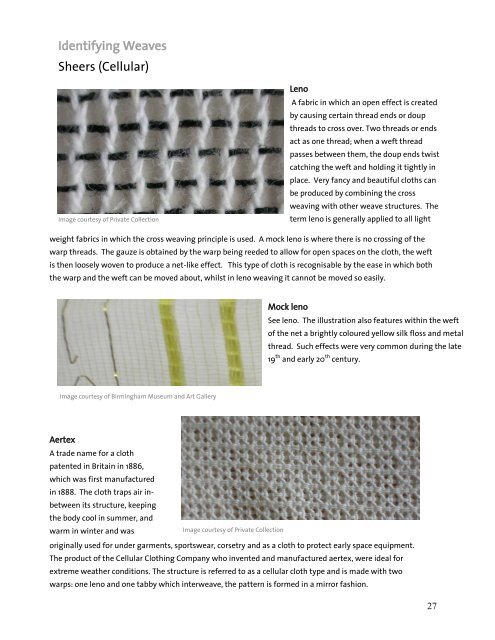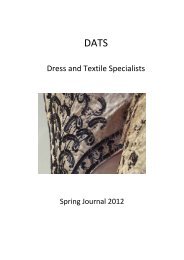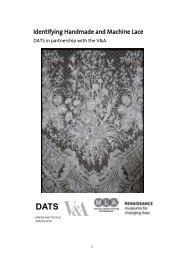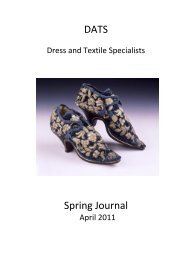Identifying Textile Types and Weaves 1750-1950 - Dress and Textile ...
Identifying Textile Types and Weaves 1750-1950 - Dress and Textile ...
Identifying Textile Types and Weaves 1750-1950 - Dress and Textile ...
You also want an ePaper? Increase the reach of your titles
YUMPU automatically turns print PDFs into web optimized ePapers that Google loves.
<strong>Identifying</strong> <strong>Weaves</strong><br />
Sheers (Cellular)<br />
Image courtesy of Private Collection<br />
Image courtesy of Birmingham Museum <strong>and</strong> Art Gallery<br />
Aertex<br />
A trade name for a cloth<br />
patented in Britain in 1886,<br />
which was first manufactured<br />
in 1888. The cloth traps air in-<br />
between its structure, keeping<br />
Image courtesy Private Collection<br />
the body cool in summer, <strong>and</strong><br />
warm in winter <strong>and</strong> I was<br />
Image courtesy of Private Collection<br />
Leno<br />
Mock leno<br />
A fabric in which an open effect is created<br />
by causing certain thread ends or doup<br />
threads to cross over. Two threads or ends<br />
act as one thread; when a weft thread<br />
passes between them, the doup ends twist<br />
catching the weft <strong>and</strong> holding it tightly in<br />
place. Very fancy <strong>and</strong> beautiful cloths can<br />
be produced by combining the cross<br />
weaving with other weave structures. The<br />
term leno is generally applied to all light<br />
weight fabrics in which the cross weaving principle is used. A mock leno is where there is no crossing of the<br />
warp threads. The gauze is obtained by the warp being reeded to allow for open spaces on the cloth, the weft<br />
is then loosely woven to produce a net-like effect. This type of cloth is recognisable by the ease in which both<br />
the warp <strong>and</strong> the weft can be moved about, whilst in leno weaving it cannot be moved so easily.<br />
See leno. The illustration also features within the weft<br />
of the net a brightly coloured yellow silk floss <strong>and</strong> metal<br />
thread. Such effects were very common during the late<br />
19 th <strong>and</strong> early 20 th century.<br />
originally used for under garments, sportswear, corsetry <strong>and</strong> as a cloth to protect early space equipment.<br />
The product of the Cellular Clothing Company who invented <strong>and</strong> manufactured aertex, were ideal for<br />
extreme weather conditions. The structure is referred to as a cellular cloth type <strong>and</strong> is made with two<br />
warps: one leno <strong>and</strong> one tabby which interweave, the pattern is formed in a mirror fashion.<br />
with aertex cloth. The structure is referred to as a cellular cloth<br />
27





